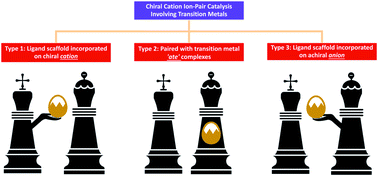Enantioselective transition metal catalysis directed by chiral cations
Abstract
Enantioselective transition metal catalysis directed by chiral cations is the amalgamation of chiral cation catalysis and organometallic catalysis. Thus far, three strategies have been revealed: ligand scaffolds incorporated on chiral cations, chiral cations paired with transition metal ‘ate’-type complexes, and ligand scaffolds incorporated on achiral anions. Chiral cation ion-pair catalysis has been successfully applied to alkylation, cycloaddition, dihydroxylation, oxohydroxylation, sulfoxidation, epoxidation and C–H borylation. This development represents an effective approach to promote the cooperation between chiral cations and transition metals, increasing the versatility and capability of both these forms of catalysts. In this review, we present current examples of the three strategies and suggest possible inclusions for the future.


 Please wait while we load your content...
Please wait while we load your content...